
by Laura Tiu | Aug 10, 2024
My son and his girlfriend were visiting last week and wanted to go fishing. Since she had never been deep sea fishing before, we decided that the best course of action would be to take the short four-hour trip on one of Destin’s party boats.
Party boats, also known as a head boat, are typically large boats from 50 to 100 feet long. They can accommodate many anglers and are an economical choice for first-time anglers, small, and large groups. The boat we went on holds up to 60 anglers, has restrooms, and a galley with snacks and drinks, although you can also bring your own. The cost per angler is usually in the $75 – $100 range and trips can last 4, 6, 8, or 10 hours.
We purchased our tickets through the online website and checked in at the booth 30 minutes before we departed. Everyone gets on and finds a spot next to a fishing pole already placed in a holder on the railing. For the four-hour trip, it is about an hour ride out to the reefs. On the way out, the enthusiastic and ever helpful deckhands explain what is going to happen and pass out a solo cup of bait, usually squid and cut mackerel, to each angler. When you get to the reef, you bait your hooks (two per rod) and the captain says, “start fishing.”
The rods are a bit heavy and there are some tricks you need to learn to correctly drop your bait 100 feet to the bottom of the Gulf. The deckhands are nearby to help any beginners and soon everyone is baiting, dropping, and reeling on their own. There are a few hazards like a sharp hook while baiting, crossing with your neighbor’s line and getting tangled, and the worst one, creating a “birds nest” by not correctly dropping your line. Nothing the deckhands can’t help with.
When you do finally catch a fish, you reel it up quickly and into the boat where a deckhand will measure it to make sure it’s a legal species and size and then use a de-hooker to place the fish in your bucket. After about 30 to 40 minutes, the captain will tell everyone to reel up before proceeding to another reef. At this time, you take your fish to the back of the boat where the deckhands put your fish on a numbered stringer and on ice.
For the four-hour trip, we fished two reefs. We had a lucky day with the three of us catching a total of 16 vermillion snapper, the most popular fish caught on Destin party boats. It’s a relaxing ride back to the harbor during which the deckhands pass the bucket to collect any tips. The recommended tip is 15-20% of your ticket price. These folks work hard and exclusively for tips, so if you had a good time, tip generously.
Once back in the harbor, your stringer of fish is placed on a board with everyone’s catch and they take the time for anyone that wants to get some pictures with the catch. Then, you can load your fish into your cooler, or the deckhands will clean your fish for you for another tip. If you get your fish filleted, you can take them to several local restaurants that will cook your catch for you along with some fries, hush puppies and coleslaw. It is an awesome way to end your day.
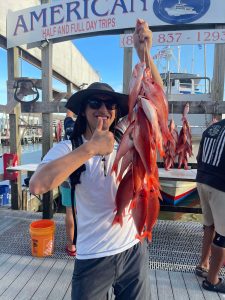
A happy angler after a party boat excursion.
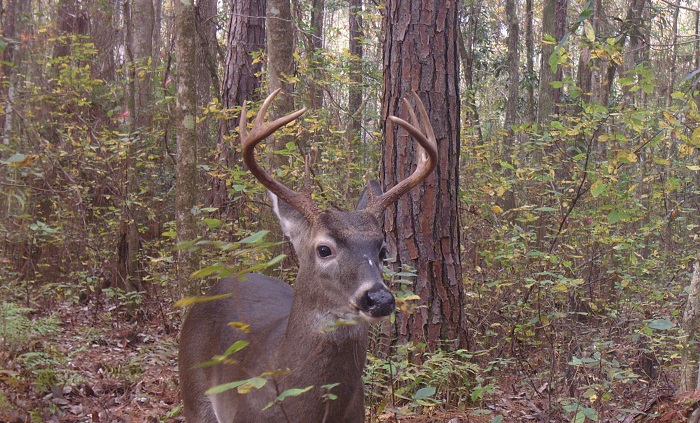
by Mark Mauldin | Aug 2, 2024
All graphics and information included are courtesy of myfwc.com.
Here in the Panhandle (FWC Zone D), we are just under 3 months away from the October 26 opening day of archery season. As we move through summer and into the home stretch of hunting season preparations it is important to be sure all hunters understand the current regulations related to deer hunting in our area – it’s more complicated than it used to be.
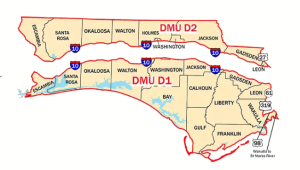
Deer Management Unit map.
From: https://myfwc.com/hunting/season-dates/dmu-d/ Click on image to make larger.
Following last summer’s discovery of Chronic Wasting Disease in Holmes County, the Chronic Wasting Disease Management Zone and its modified regulations will remain in place for the 2024-25 hunting season, but with some notable changes. The entirety of the Chronic Wasting Disease Management Zone lies within Deer Management Unit (DMU) D2. DMU-D2 is the portion of Zone D which lies north of I-10. As such, there are now some considerable differences in the hunting regulations north and south of I-10. For those of us who live along the I-10 corridor and who have opportunities to hunt on both sides of the interstate this could prove a bit confusing. The following is a discussion of the new regulations and how they differ by DMU.
New for the 2024-25 Hunting Season
The feeding of deer within the CWD Management Zone shall be allowed only during the deer hunting season (October 26, 2024 – March 2, 2025). This regulation is specific to the CWD Management Zone, not all of DMU-D2. Anywhere in Florida outside of the CWD Management Zone feeding stations must be continuously maintained with feed for at least 6 months before they are hunted over. So, unless you are hunting inside the CWD Management Zone, I hope your feeders have already been up and running for quite a while.
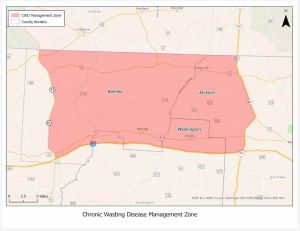
Chronic Wasting Disease Management Zone From: https://myfwc.com/research/wildlife/health/white-tail-deer/cwd/ Click on image to make larger.
The take of antlerless deer shall be allowed during the entire deer season in Deer Management Unit D2 on lands outside of the WMA system. For all of DMU-D2 there are no “doe days”. If it is hunting season (October 26, 2024 – March 2, 2025), it is legal to harvest antlerless deer in DMU-D2. This is quite different south of I-10, in DMU-D1, where antlerless deer may only be harvested during archery /crossbow season (Oct. 26 – Nov. 27), youth deer hunt weekend* (Dec. 7–8), and specific dates during general gun season (Nov. 30 – Dec. 1, Dec. 28–29).
Up to three antlerless deer, as part of the statewide annual bag limit of five, may be taken in DMU D2 on lands outside of the WMA system. Outside of DMU-D2, there can be no more than 2 antlerless deer included in the annual bag limit of five deer. Event if you hunt outside of DMU-D2 you still have the opportunity to harvest 3 antlerless deer in the 2024-25 season, but at least one of them must be harvested in DMU-D2. The bag limit of 5 total deer remains in place for all DMUs.
All CWD management related regulations can be found here.
Antler Regulations
While it is not new this hunting season, it should be noted that there are different antler regulations north and south of I-10.
DMU-D1 (south of the intestate) – To be legal to take, all antlered deer (deer with at least one antler 5 inches or longer) must have an antler with at least 2 points with each point measuring one inch or more. Hunters 16 years of age and older may not take during any season or by any method an antlered deer not meeting this criteria.
DMU-D2 (north of the interstate) – To be legal to take, all antlered deer (deer with at least one antler 5 inches or longer) must have an antler with 1) at least 3 points with each point measuring one inch or more OR 2) a main beam length of 10 inches or more. Hunters 16 years of age and older may not take during any season or by any method an antlered deer not meeting this criteria.
In both DMU-D1 & D2 as part of their annual statewide antlered deer bag limit, youth 15-years-old and younger may harvest 1 deer annually not meeting antler criteria but having at least 1 antler 5 inches or more in length.
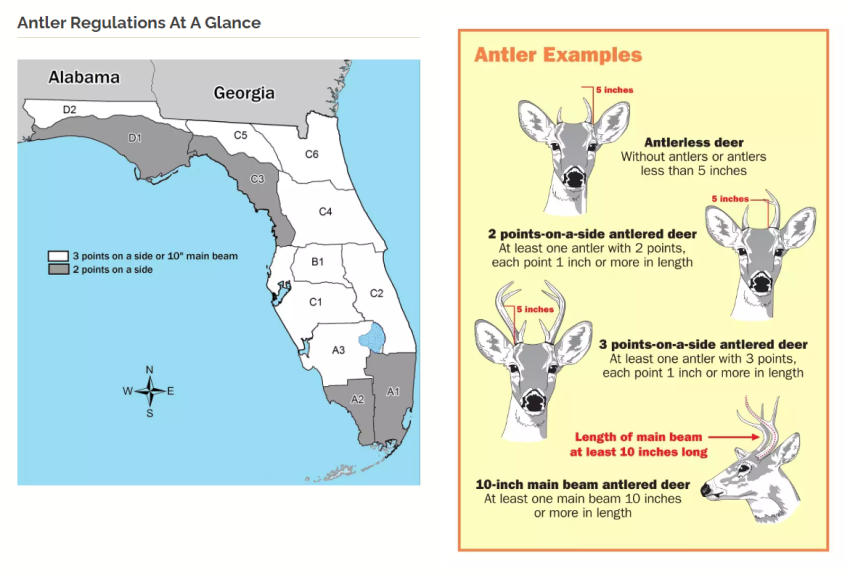
Florida Antler Regulations
From: https://myfwc.com/hunting/season-dates/dmu-d/
Harvest Reporting
Another somewhat new concept that some hunters still might not be accustomed to is Logging and Reporting Harvested Deer and Turkeys. All hunters must (Step 1) log their harvested deer and wild turkey prior to moving it from the point where the hunter located the harvested animal, and (Step 2) report their harvested deer and wild turkey within 24 hours.**
**Hunters must report harvested deer and wild turkey: 1) within 24 hours of harvest, or 2) prior to final processing, or 3) prior to the deer or wild turkey or any parts thereof being transferred to a meat processor or taxidermist, or 4) prior to the deer or wild turkey leaving the state, whichever occurs first.
Hunters have the following user-friendly options for logging and reporting their harvested deer and wild turkey:
Option A – Log and Report (Steps 1 and 2) on a mobile device with the FWC Fish|Hunt Florida App or at GoOutdoorsFlorida.com prior to moving the deer or wild turkey.
Option B – Log (Step 1) on a paper harvest log prior to moving the deer or wild turkey and then report (Step 2) at GoOutdoorsFlorida.com or Fish|Hunt Florida App or calling 888-HUNT-FLORIDA (888-486-8356) within 24 hours.
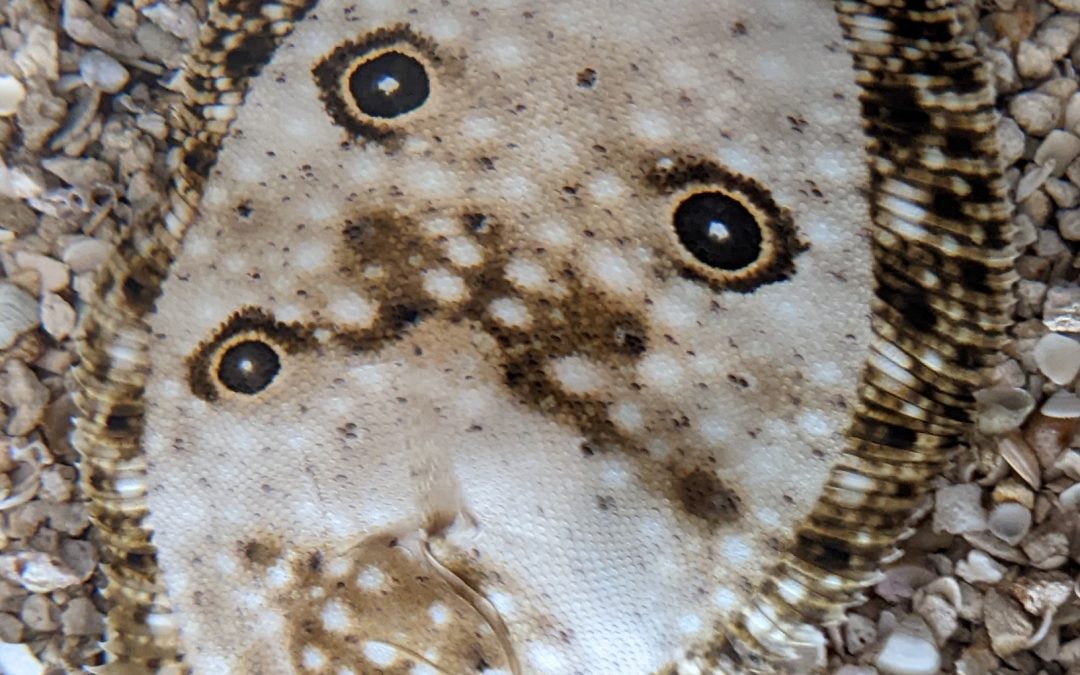
by Erik Lovestrand | Jun 28, 2024
One of several “flatfish” inhabiting our Panhandle coastal waters, the ocellated flounder (Ancylopsetta ommata) is one of the more striking species, in my opinion. From the four distinctive eye spots (ocelli) to its incredible variability in background patterns, I must just say that it is a beautiful creature. Flounders are unique among fish, in that early during larval development one eye will migrate over to join the other and the fish will orient to lay on its side when at rest. Only the top side will have coloration and the bottom side will be white. While the eyes end up on the same side, the pectoral and pelvic fins remain in their traditional positions, although the bottom-side pectoral fin is reduced in size.
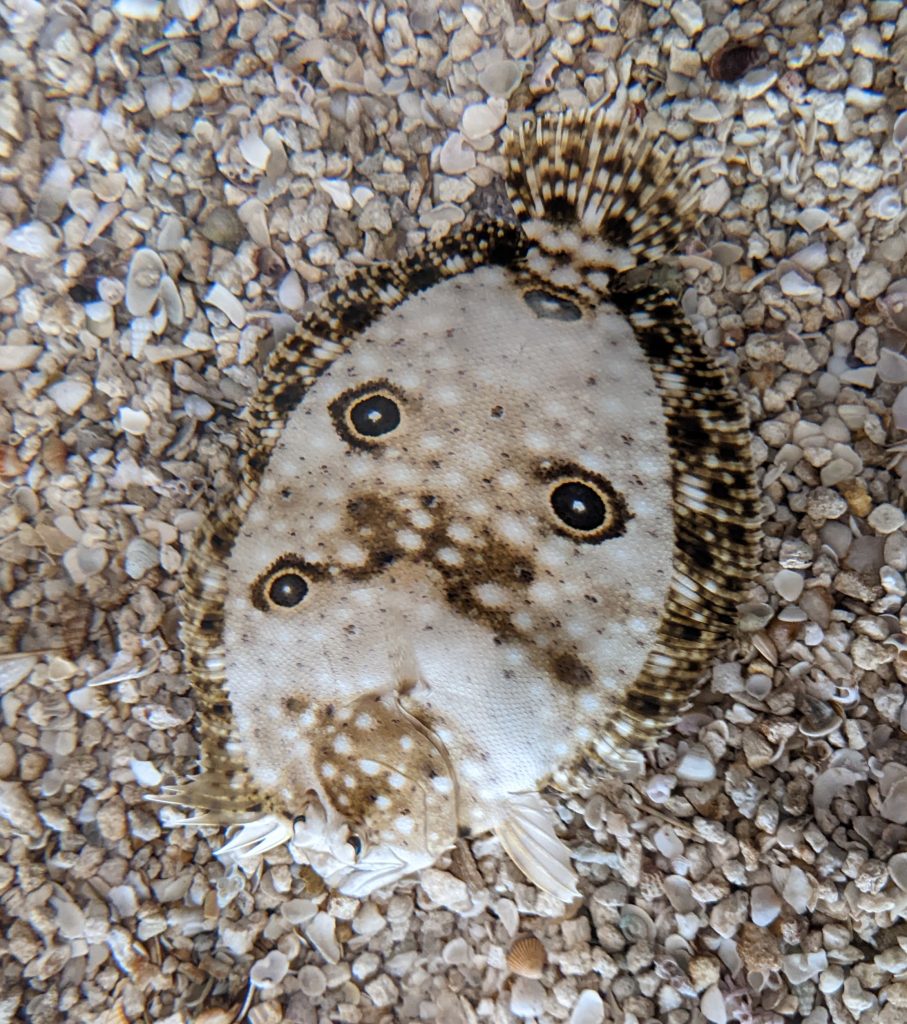
Not the Biggest but Definitely one of the Coolest Flounder Species Around
Ocellated flounders are always left-eyed, meaning if you stood them up vertically with their pelvic fins down, the left side of the body has the eyes. When laying on the ocean floor, their independently moving eyes can keep a lookout in all directions. However, flounders tend to remain immobile when approached, depending on an awesome ability to camouflage themselves from predators. They can flip sand or gravel onto their top side which hides their outline and their ability to match the color and texture of the surrounding substrate is phenomenal.
This species is a fairly small fish, reaching lengths of about ten inches. However, they are by no means the smallest flatfish around. We also have hogchokers (a member of the sole family, 6-8 in.) and blackcheek tonguefish (to 9 in.). These are dwarfed by the larger Gulf flounder and Southern flounder which are highly prized table fare by fishers along our coasts and can reach sizes that earn them the nickname of “doormat” flounders. Regardless of the species of flounder you observe, it is unquestionably one of the super cool animals we have the privilege of living with here along the North Florida Gulf Coast.
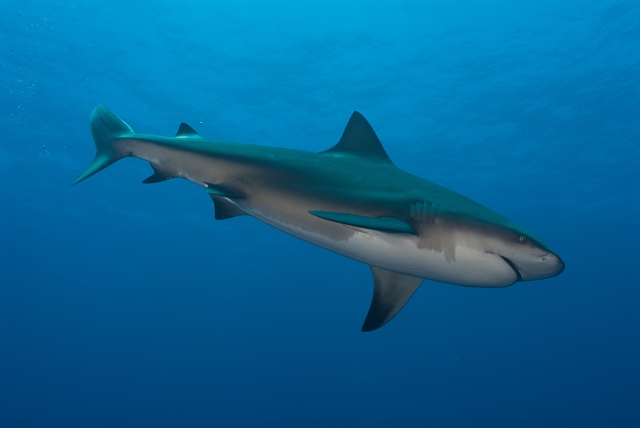
by Rick O'Connor | Jun 21, 2024
Today’s society is more educated about sharks and shark behavior than our forefathers. In the 18th, 19th, and much of the 20th century we thought of sharks as mindless eating machines – consuming anything available. Whalers would witness sharks consuming carcasses, as did many other fishermen. Sailors noted sharks following the smaller boats across the ocean, always present when bad situations occurred.
During World War II the U.S. Navy was moving across the Pacific and a deeper understanding of sharks was needed to keep servicemen safe. The sinking of the USS Indianapolis pushed the Navy into a larger research program to determine how to repel sharks and better understand what made them tick. After the war funding for such research continued. One of the leading researchers was Dr. Eugene Clark, who eventually founded the Mote Marine Laboratory in Sarasota with the intention of developing a better understanding of shark behavior. Dr. Clark frequently appeared on the Undersea World of Jacques Cousteau educating the public about how sharks function and respond to their environment. All with the idea of how to better reduce negative shark encounters.
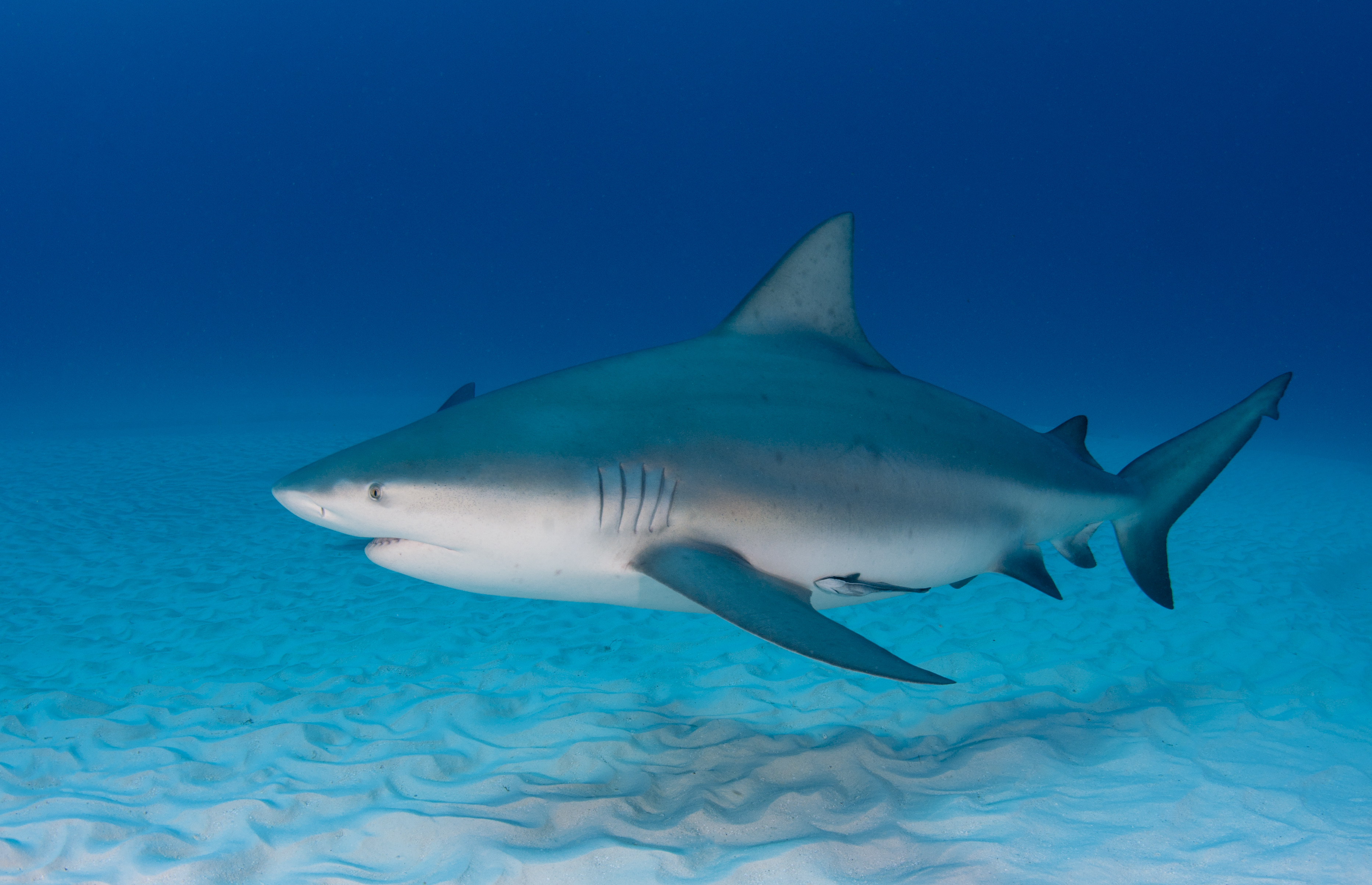
Pregnant Bull Shark (Carcharhinus leucas) cruses sandy seafloor. Credit Florida Sea Grant Stock Photo
In the 1970s Peter Benchley wrote Jaws but included a marine biologist as one of the key characters who would provide science insight into how sharks work. The film was a cultural phenomenon. I remember standing in a line that wrapped the cinema twice to get in. This was followed by more funding for shark research and a better understanding of how they work. This was then followed by a popular summer series known as “Shark Week”, which remains popular to this day. Many of the old tales of shark behavior were disproved or explained. The idea of a mindless eating machine was replaced with a fish that actually thinks and responds to certain cues. People began to realize that shark attacks are quite rare and could be explained if we understood what happened leading up to the attack.
We now understand that sharks are fish, in a class where the members have cartilaginous skeletons (they lack true bone). They are one of the most perceptive creatures in the ocean, using their senses to detect potential prey and that there are signals that can “turn them on”. On the side of their bodies there is a line of small gelatinous cells that can detect slight vibrations in the ocean – from up to a mile away. The ocean is a noisy place, and it appears that sharks respond to different frequencies. I like to use the analogy of yourself being in a large student cafeteria. Everyone is talking and it is very noisy. Then someone calls your name. Somehow, amongst all the background clatter, you hear this and respond to it. Studies suggest that sharks do the same. With all of the noise moving though the ocean, sharks hear things that catch their attention and then move towards the source.
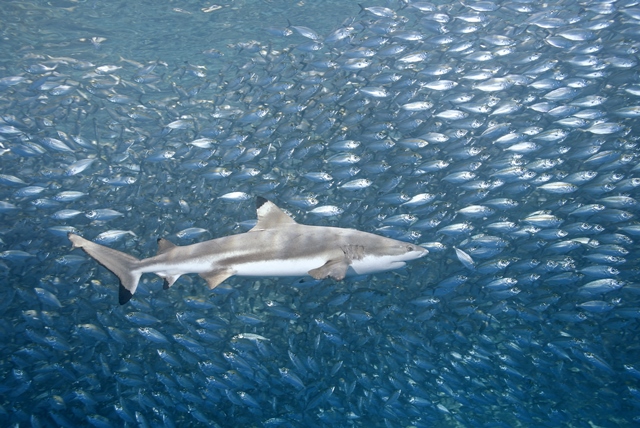
Blacktip sharks are one of the smaller sharks in our area reaching a length of 59 inches. They are known to leap from the water. Photo: Florida Sea Grant
As they get closer their sense of smell kicks in. Everyone has heard that sharks can detect small amounts of blood in large amounts of seawater – remember “Bruce” from Finding Nemo? It is true, but they do have to be down current to pick up the scent and they will now focus their search to find the source. Some studies suggest other “odors”, such as the urine of seals, might produce the same reaction that blood does. All may lead to shark to think a possible meal is nearby.
Eyesight is not great with any creature in the sea. Light does not travel well in water – but sharks do have eyes and they do see well (one of the old tales science disproved – that sharks are basically “blind”). However, because of the low light, they do have to be close to the target to get a visual. Some studies suggest that sharks are detecting shadows or shapes they may confuse as a potential prey, bite it, and then release when they discover it was not what they thought it was. This idea is supported by the fact that many who are bitten experience what is called “bite and release” – and they turn and swim away. It is also known that sharks have structures in the back of their retinas that act as mirrors, collecting what light is available, reflecting it within the eye, and illuminating their world. They believe they see pretty well at night – better than us for sure. The image they see may appear to be a prey item and may be what is producing the vibrations and odors that they detected.

The Scalloped Hammerhead is one of five species of hammerheads in the Gulf. It is commonly found in the bays. Photo: Florida Sea Grant
And they have one more “sixth sense” – the ability to detect weak electric fields. The shark’s mouth is not in position to attack prey as they move forward. It is on the bottom of their head and, one of the old tales, was that sharks must swim over their prey to bite it. Video taken during the filming for Jaws showed that the shape of the shark’s head changes at the last moment of an attack. The entire head becomes distorted to get the mouth in the correct position for the bite. The “eyes roll back” – as the old fishermen used to say – and the jaws move up and forward. At this point the shark can no longer use its eyes to zero in on the target. However, they have small cells around their snout called the Ampullae of Lorenzini that can detect the small electric fields produced by muscle movement – even the prey’s heartbeat – and know where they are. But – they must be very close to the prey to detect this.
Understanding all of this gives scientists, and the public, a better idea of how sharks work. What “turns them on” and how/when they will select prey. One thing that has come from all of this is that we do not seem to be high on their target list.
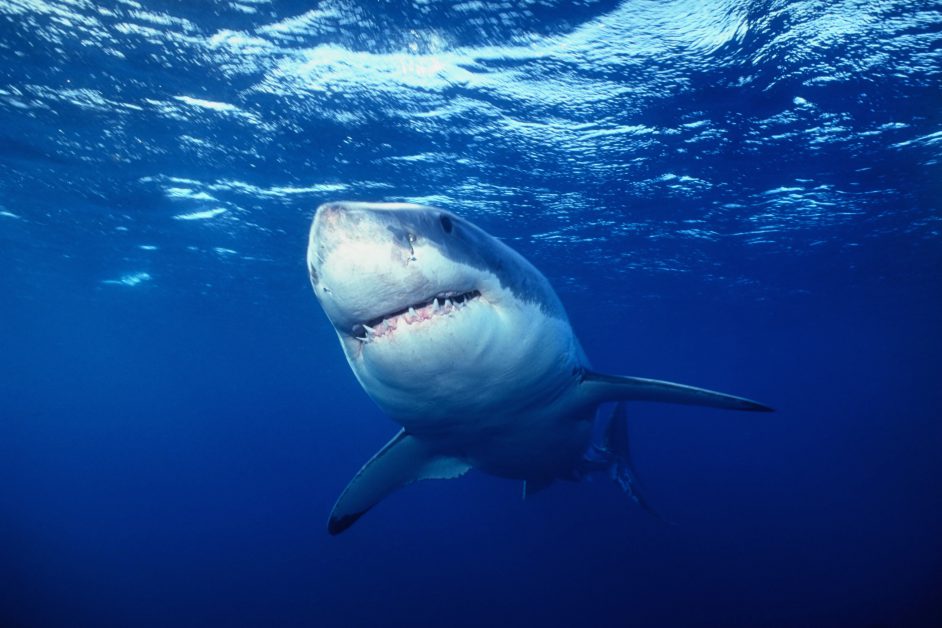
The Great White shark.
Photo: UF IFAS
The International Shark Attack File is kept at the Florida Museum of Natural History in Gainesville. It has cataloged shark attacks from around the world dating back to 1580. The File only catalogs UNPROVOKED attacks. With provoked attacks – those occurring while people are grabbing them, or fishing for them, or in some way provoked an attack – we understand why the shark bit the human. It is the unprovoked attacks that are of more interest. Those where the person was not doing anything intentionally to invite a shark bite, but it happened.
One thing we can tell from this data is that unprovoked attacks are not common. Since 1580, they have logged 3,403 unprovoked shark attacks worldwide. Considering how many people have swum in the ocean since 1580, this is a very small number. Note, the File is only as good as the reports it gets. In the past, many unprovoked attacks were not reported. But in our modern age of communication, it is rare that such an attack does not make the headlines today.

The Bull Shark is considered one of the more dangerous sharks in the Gulf. This fish can enter freshwater but rarely swims far upstream. Photo: Florida Sea Grant
Of these attacks 1,640 (48%) have occurred in the United States, followed by 706 in Australia. Many have explained this by the large levels of water activities people in both countries participate in. In the US Florida leads the way with 928 unprovoked attacks (57%), most of these (351 – 34%) are from Volusia County. This may be due to breakthrough emergency communications with Volusia County and thus more reports. Many of the reports are minor, small bites from small sharks such as blacktips, but unprovoked none the less. There are 26 unprovoked attacks logged from the Florida panhandle – 3% of the state total – and most of these (n=9) were from Bay County.
When looking at what people were doing when attacked, most were at the surface and participating in some surface water activity such as surfing, skiing, boogie boarding, etc. This is followed by surface swimming or snorkeling.
This brings us to the attacks this summer in the panhandle. There have been a lot of questions as to what may have caused them. They are still assessing the situation before and during these attacks to try and determine why they happened. As we have mentioned, we have learned a lot about sharks and shark behaviors over the last 50 years and several hypotheses are open for discussion. We will see what the investigators learn. Until then, the International Shark Attack File does offer a page on how you can reduce your risk. There is “Advice to Swimmers”, “Advice to Divers”, “Color of Apparel”, “Menstruation and Sharks”, “Quick Tips”, “Advice to Spearfishers”, and “How to Avoid a Shark Attack”. Read more on these tips at https://www.floridamuseum.ufl.edu/shark-attacks/reduce-risk/.
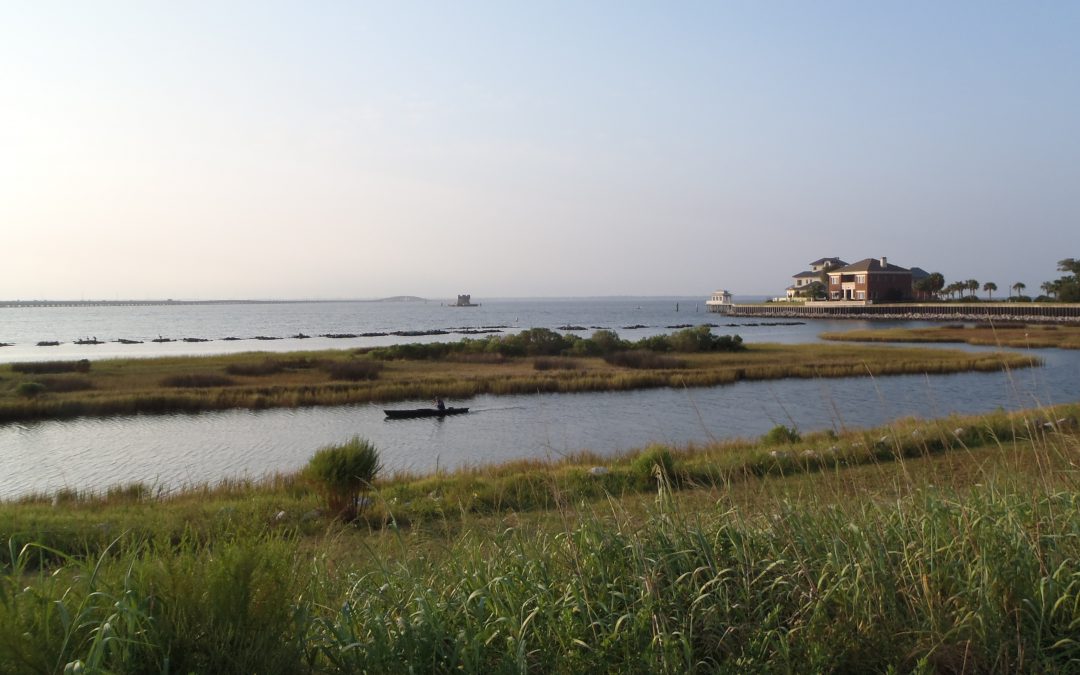
by Thomas Derbes II | Jun 21, 2024
In Part 1 of The Estuary’s Natural Filtration System article, we discussed the major contributors to natural filtration inside of the estuary. These examples included oysters, marsh plants, and seagrasses. In Part 2, we will discuss the smaller filter-feeding organisms including tunicates, barnacles, clams, and anemones.
Tunicates
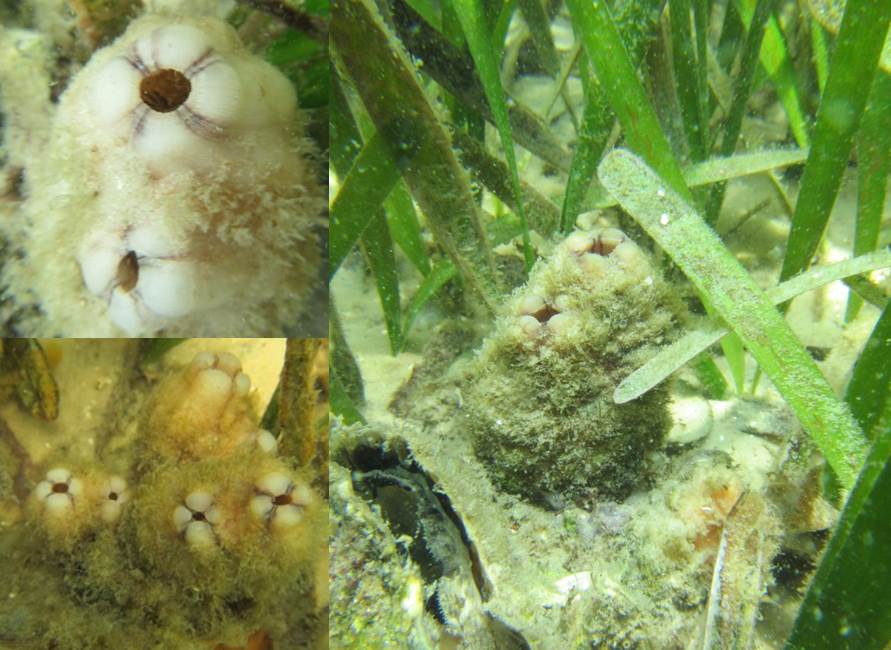
Pleated Sea Squirt – Photo Credit: Don Levitan, PH.D. FSU
Tunicates, also known as sea squirts, are very interesting marine invertebrates and can be easily confused for a sponge. There are many different types of tunicates in the estuaries and can be either solitary or colonial. You might’ve seen these at an aquarium attached to different substrates, and when removed from the water, their name sea squirt comes into play. Tunicates have a defense mechanism to shoot out the water inside their body in hopes of being released by any predator.
Tunicates are filter feeders and intake water through their inhalant siphons and expel waste and filtered water through their exhalant siphons. Tunicates can filter out phytoplankton, algae, detritus, and other suspended nutrients. The tunicate produces a mucus that catches these nutrients as it passes through, and the mucus is then conveyed to the intestine where it is digested and absorbed.
An invader to the Gulf of Mexico, the Pleated Sea Squirt (Styela plicata), hitched rides on the hulls of ships and found the Gulf of Mexico waters very favorable. You can sometimes spot these organisms on ropes that have been submerged for a long period of time in salty waters. Even though they are non-native, these sea squirts can filter, on average, 19 gallons of water per day.
Barnacles
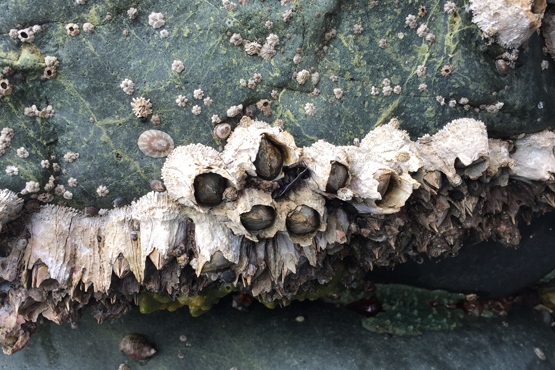
Barnacles along the seashore is a common site for many.
Photo: NOAA
One organism that seems ubiquitous worldwide is the barnacle (Genus Semibalanus and Genus Lepas). The Genus Semibalanus contains the common encrusting barnacle we are accustomed to seeing in our waterways along pilings, submerged rocks, and even other animals (turtles, whales, crabs, and oysters). The Genus Lepas contains Gooseneck Barnacles and can be seen attached to flotsam, floating organic debris, and other hard surfaces and have a stalk that attaches them to their substrate. Interesting fact, certain gooseneck barnacle species are eaten in different parts of the world.
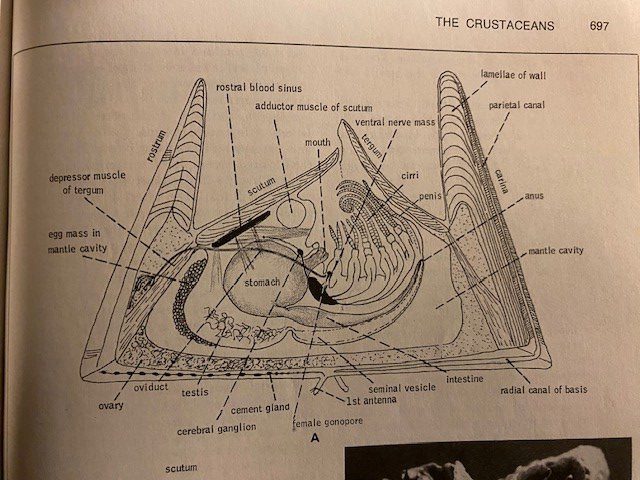
This image from a textbook shows the internal structure of a barnacle. Notice the shrimplike animal on its back with extendable appendages (cirri) for feeding.
Image: Robert Barnes Invertebrate Zoology.
Barnacles have over 2,100 species, are closely related to crabs and lobsters, and are a part of the subphylum Crustacea. At first glance, you might not think a barnacle is closely related to crabs, but when you remove the hard plates surrounding it, the body looks very similar to a crab. Barnacles also have life cycle stages that are similar to crabs; the nauplius and cyprid developmental stages. Inside of the hard plates is an organism with large feather-like appendages called cirri. When covered by water, the barnacles will extend their cirri into the water and trap microscopic particles like detritus, algae, and zooplankton. Barnacles are at the mercy of tides and currents, which makes quantifying their filtering ability difficult.
Hard Clams
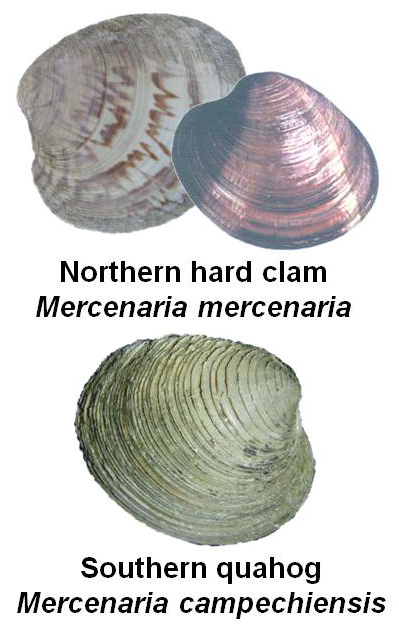
Clams of North Florida – UF/IFAS Shellfish
Even though not as abundant in the Florida Panhandle as they were in the 1970’s – 1980’s, hard clams (Mercenaria mercenaria and M. campechiensis) can still be found in the sand along the shoreline and near seagrass beds. These clams are also known as Quahogs and are in the family Veneridae, commonly known as the Venus clam family, and contain over 500 living species. Most of the clams in the family Veneridae are edible and Quahogs are the types of clams you would see in a clam chowder or clam bake.
Being the only bivalve on this list does not make it any less important than the oyster or scallop on Part 1’s list. In fact, a full-grown adult Southern Quahog clam can filter upwards of 20 gallons of water per day and have a lifespan of up to 30 years. Clams also live a much different lifestyle than their oyster and scallop cousins. Clams spend the majority of their life under the sand. Their movement under the sand helps aerate and mix the soil, which can sometimes stimulate seagrass growth.
Right outside the Florida Panhandle and in the Big Bend area, Quahog clams are commercially farmed in Cedar Key. Southern Quahog clams are also being used for restoration work in South Florida. Clams are being bred in a hatchery and their “seed” are being released into Sarasota Bay to help tackle the Red Tide (Karenia brevis) issue. According to the project’s website, they have added over 2 million clams since 2016, and the clams are filtering over 20 million gallons of seawater daily.
Anemones
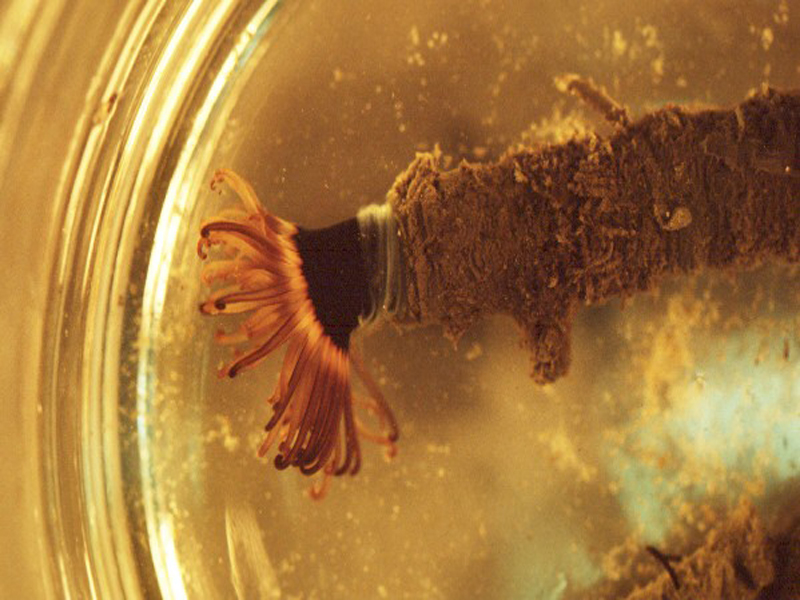
Tube-Dwelling Anemone Under Dissection Scope – UF/IFAS Shellfish
Anemones are beautiful Cnidarians resembling an upside-down, attached jellyfish, which couldn’t be closer to the truth. The phylum Cnidaria contains over 11,000 species of aquatic animals including corals, hydroids, sea anemones, and, you guessed it, jellyfish. Anemones come in many different shapes and sizes, but the common estuary anemones include the tube-dwelling anemone (Ceriantheopsis americana) and the tricolor anemone (Calliactis tricolor), also known as the hitchhiking anemone. If you have ever owned a saltwater aquarium, you might have run into the pest anemone Aiptasia (Aiptasia sp.).
Anemones filter feed with their tentacles by catching plankton, detritus, and other nutrients as the tide and current flows. The tentacles of the anemone are lined with cnidocytes that contain small amounts of poison that will stun or paralyze the prey. The cnidae are triggered to release when an organism touches the tentacles. If the anemone is successful in immobilizing the prey, the anemone will guide the prey to their mouth with the tentacles. Just like the barnacle, anemones are at the mercy of the tides and currents, and filtration rates are hard to calculate. However, if you ever see an anemone with food around, they move those tentacles to and from their mouths quickly and constantly!
In Parting
As you can see, there are many different natural filters in our estuary. Healthy, efficiently filtering estuaries are very important for the local community and the quality of the waters we love and enjoy. For more information on our watersheds and estuaries and how to protect them, visit Sea Grant’s Guide To Estuary-Friendly Living.
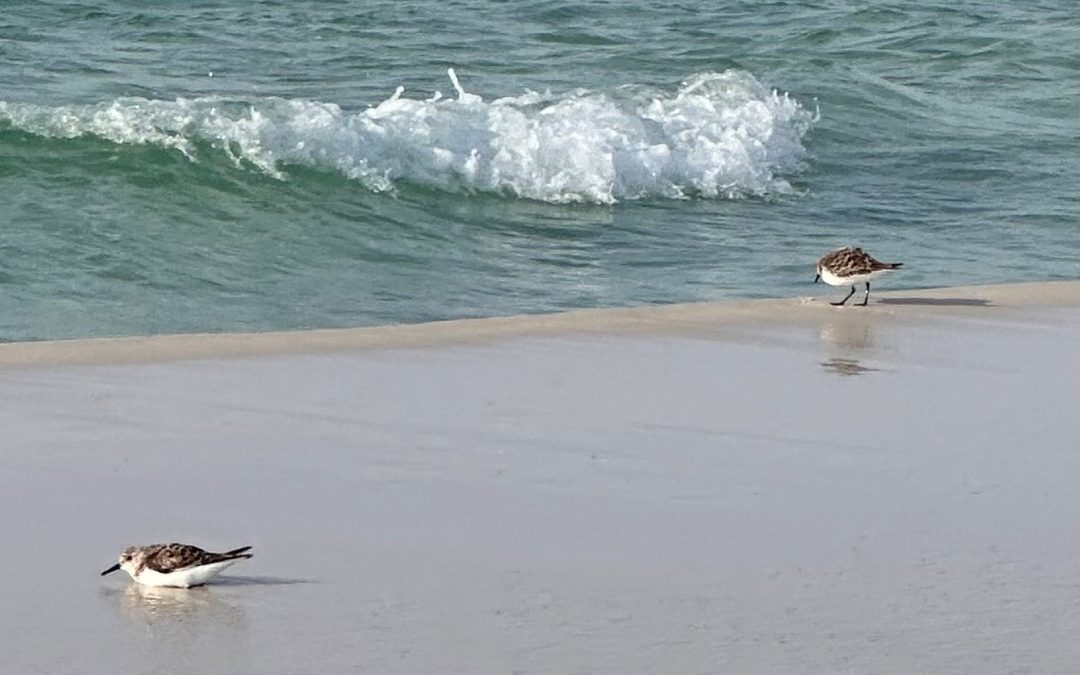
by Thomas Derbes II | May 3, 2024
I might shock a few people when I say this, but I’d rather be out in the bay somewhere rather than the beach. I just feel like I always bring a gallon of sand back on me even after washing down before getting in the car. However, there is one activity that will always get me out on the beach, and it just so happens to be the right time of the year for it. Florida Pompano (Trachinotus carolinus), aka Pompa-Yes, have started to cruise the white, sandy beaches in search of food as they migrate west to their breeding grounds. While out on a fishing trip this past weekend, the Pompano (and every other fish) eluded me, but I was blessed with an amazing array of wildlife.
When I first arrived at my spot just to the east of Portofino Towers, I was greeted with a pair of Sanderlings (Calidris alba) playing the “water is lava” game while taking breaks between waves to argue with each other and probe the sand with their beaks from marine invertebrates. When I was doing more research on sanderlings, one comment I saw was that they ran like wind-up toys, and that’s the truth! They were pretty brave too, not a single footprint of mine in the wet sand didn’t go un-probed. Sanderlings are “extremely long-distance” migratory birds that breed on the arctic tundra close to the North Pole and winter on most of the sandy beaches in the Gulf of Mexico and around the world. Non-breeding sanderlings will often stay on sandy beaches throughout the summer to save energy. They were great entertainment for the whole fishing trip.
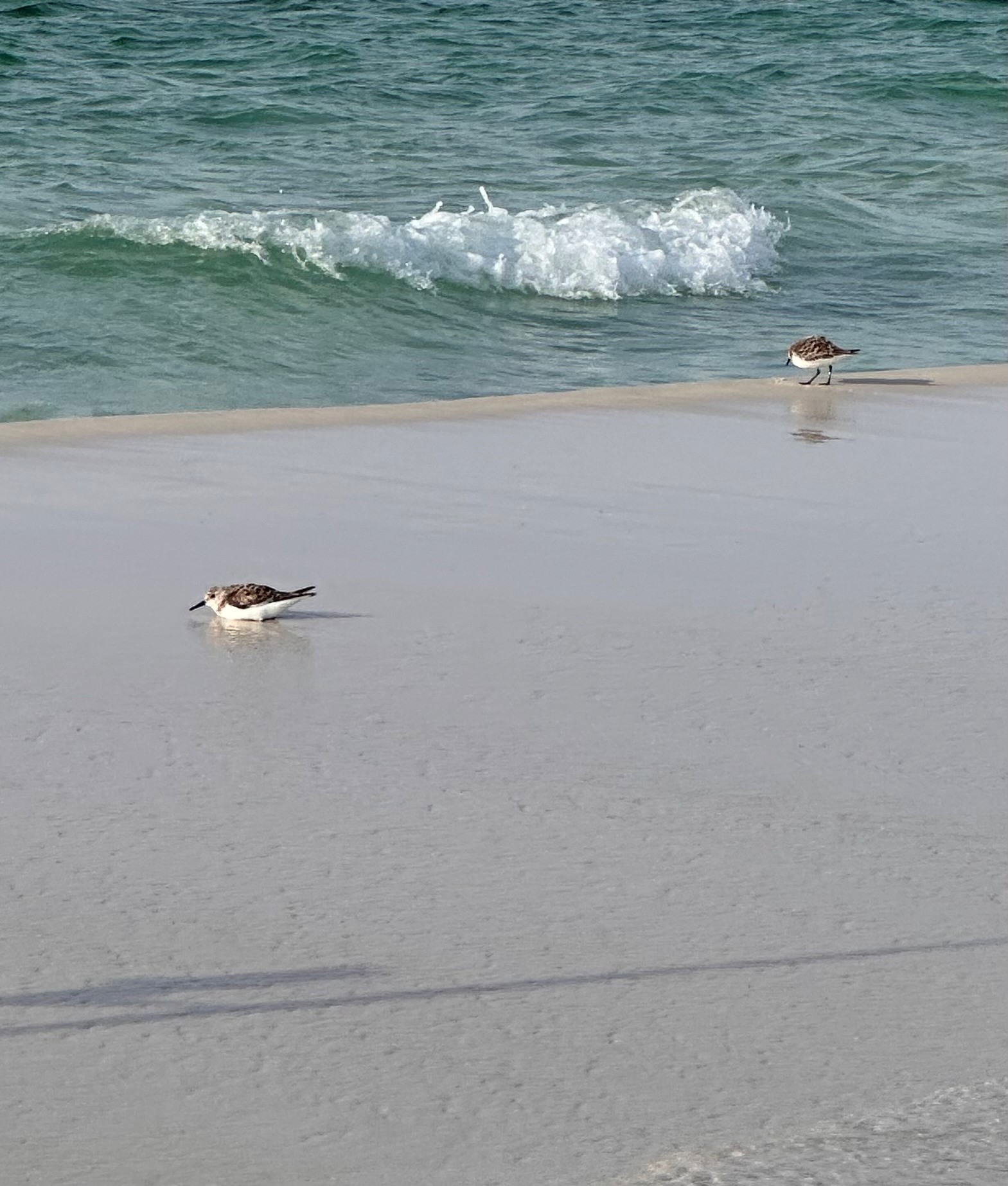
Sanderlings in the Tide Pool – Thomas Derbes II
Brown Pelicans (Pelecanus occidentalis) were out in numbers that day. I am not the best photographer, but I was very proud to capture a Pelican mid-flight. These birds are residents of the Florida Panhandle year-round. If you’ve ever been to Pensacola, you might have bumped into one of the many Pelican Statues around the area, and they’re pretty much the unofficial mascot of the area. I am always amazed at how these seemingly big, clumsy birds can effortlessly glide over the waves and water as if they are the Blue Angels doing a low-pass. Pelicans were almost wiped out by pesticide pollution in the 1960’s, but they have made an incredible comeback.

Brown Pelican – Thomas Derbes II
While I was waiting for a Pompano to bite, I had a visit from a small Atlantic Stingray (Dasyatis sabina) that was caught in the tidepool that was running along the beach. He didn’t seem injured or sick, so I quickly grabbed a glove and released him into the gulf. Stingrays are pretty incredible creatures and can get to massive sizes, but they do contain a large, venomous spine on their tail that poses a threat to beach goers. They are not aggressive however, and a simple remedy to make sure you don’t get hit is to do the “Stingray Shuffle” by shuffling your feet while you move in the water to scare up the stingrays.
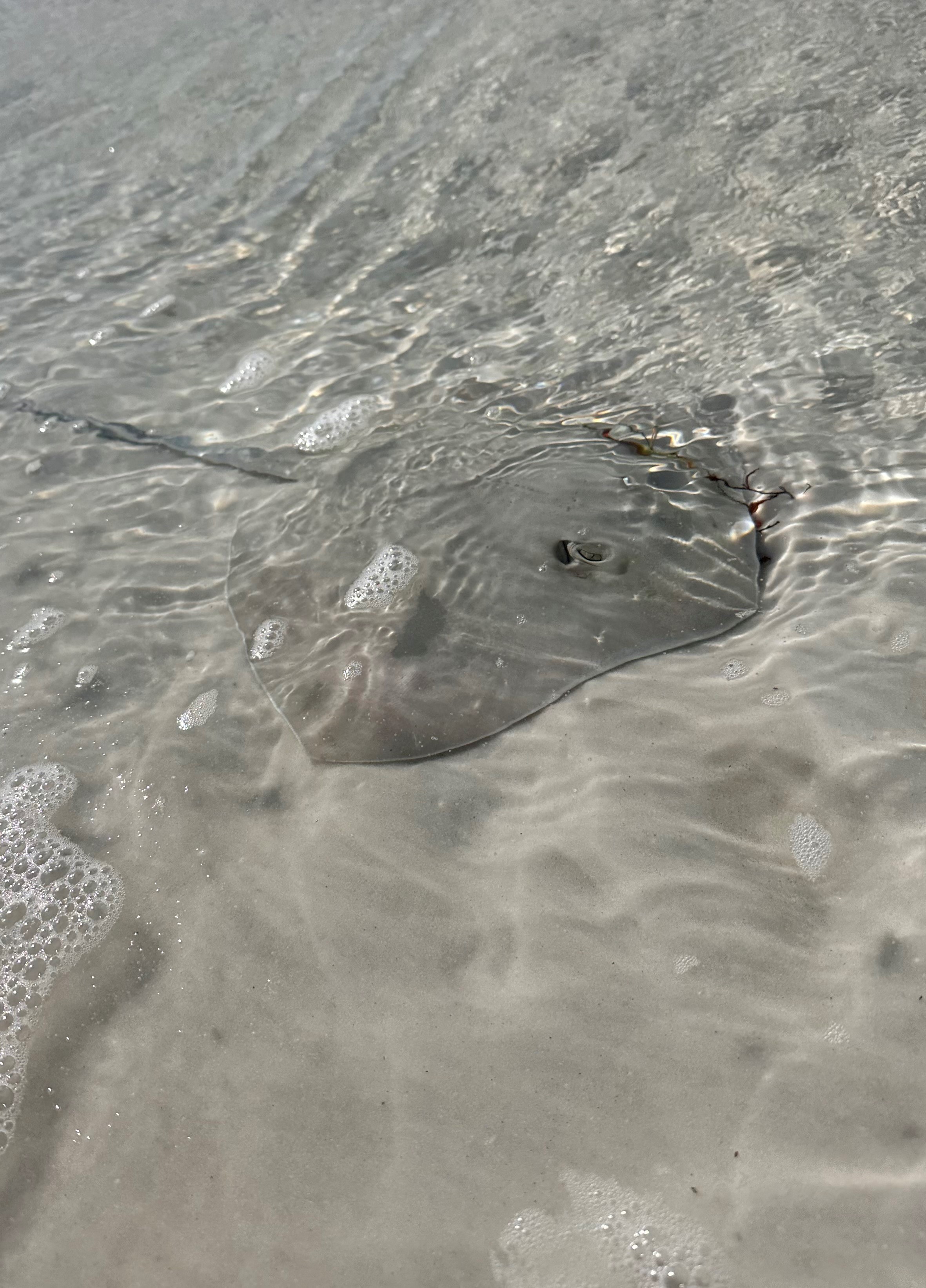
Atlantic Stingray Cruising the Tide Pool- Thomas Derbes II
As I was getting ready to pack up, I noticed a new shorebird flying in to investigate the seaweed that had washed up on shore. I had a hard time identifying this bird, but once I was able to see it in flight with its white stripe down the back, I realized it was a Ruddy Turnstone (Arenaria interpres). Turnstones get their name from their foraging behavior of turning over stones and pebbles to find food. Even though we do not have pebbles, the turnstone was looking through the seaweed for any insects or crustaceans that might be an easy meal. Turnstones are also “extremely long-distance” migratory birds breeding in the arctic tundra with non-breeding populations typically staying on sandy beaches during the summer. The turnstone made sure to stay away from me, but I was able to get a good photo of it as it ran from seaweed clump to clump.
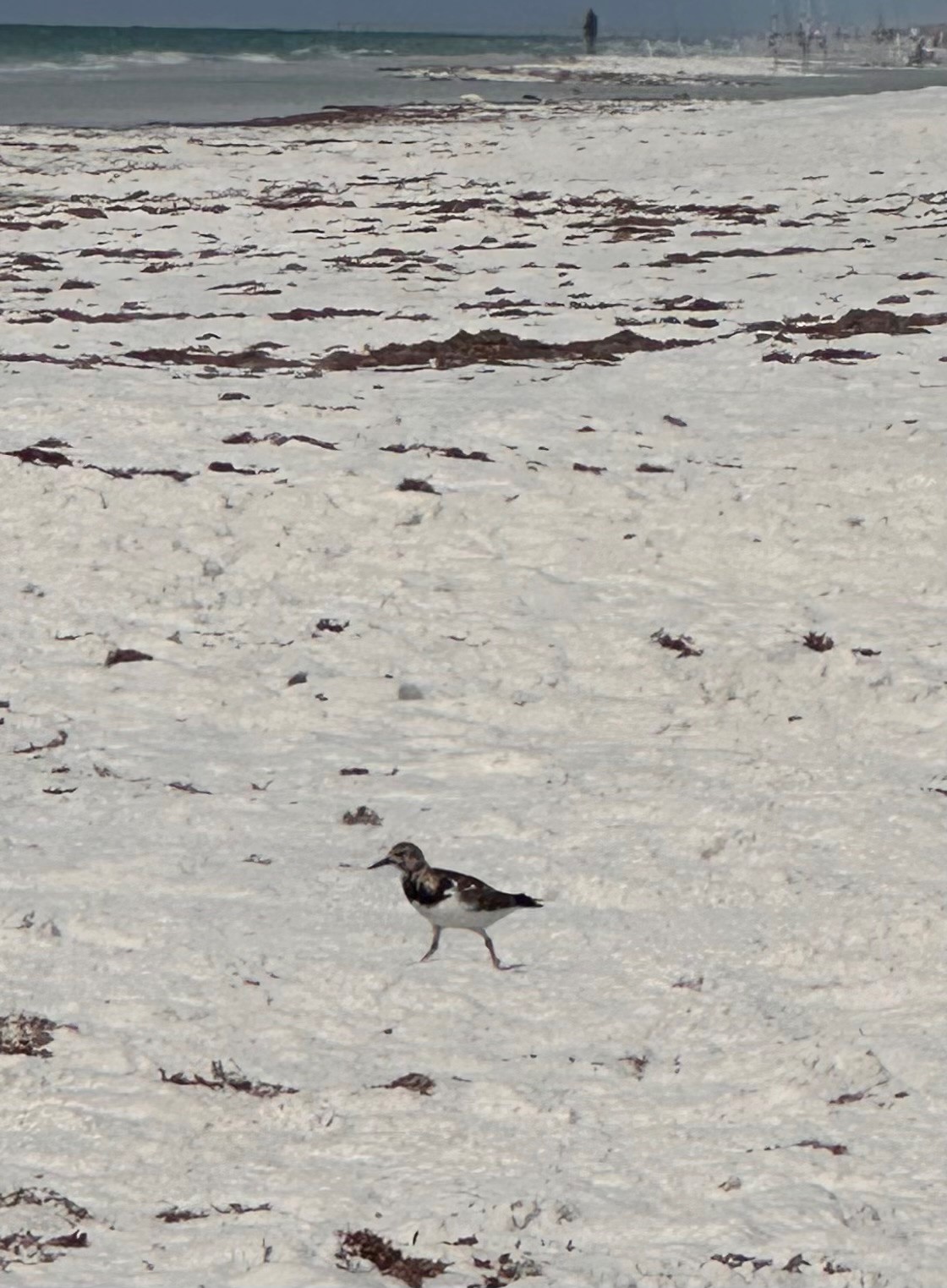
Ruddy Turnstone – Thomas Derbes II
While I didn’t catch anything to bring home for dinner, I did get to enjoy the beautiful day and playful wildlife that I wouldn’t have experienced sitting on a couch. You can turn any bad fishing day into an enjoyable day if you pay attention to the wildlife around you!
























